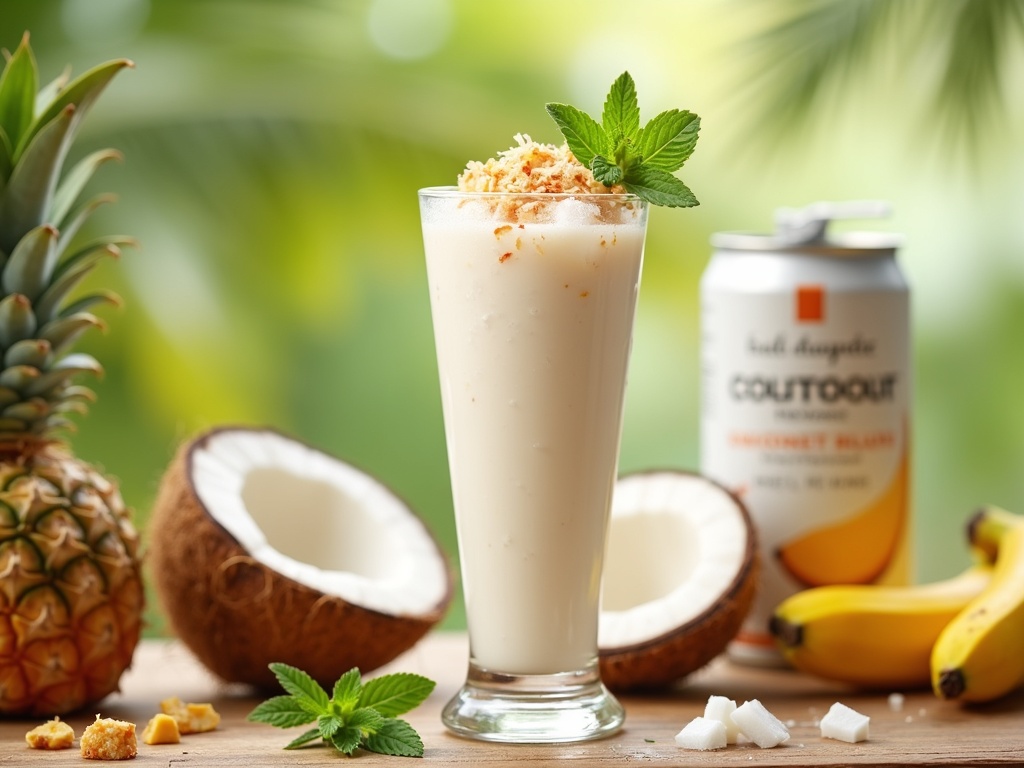Coconut shakes stand out as a refreshing tropical beverage that combines creamy texture with natural sweetness while delivering impressive nutritional benefits.
Find In This Article
Key Takeaways
- Coconut shakes provide medium-chain triglycerides (MCTs) that offer quick energy along with electrolytes like potassium and magnesium for natural hydration.
- The basic recipe is customizable with various fruits, sweeteners, and protein additions, allowing you to tailor it to your taste preferences and nutritional needs.
- Using high-quality coconut milk and proper blending techniques (short pulses rather than extended blending) are crucial for achieving the ideal creamy texture.
- Coconut shakes are best consumed immediately after preparation, though they can be stored for up to 24 hours with proper refrigeration techniques.
- For maximum flavor and texture, using chilled ingredients and adjusting sweetness gradually helps create the perfect balance in your coconut shake.
Why You Need This Refreshing Coconut Shake
Hot days call for cool drinks, and nothing beats the tropical flavor of a homemade coconut shake. I’ve found that this delicious beverage isn’t just a treat for your taste buds—it’s a refreshing escape that transports you to a beachside paradise with every sip.
A Healthier Choice For Your Thirst
Traditional milkshakes and store-bought smoothies often pack enormous amounts of sugar and artificial ingredients. A coconut shake, on the other hand, offers a naturally sweet alternative that doesn’t compromise on flavor. The natural sweetness of coconut pairs perfectly with other tropical fruits for a drink that satisfies cravings without the sugar crash later.
Coconut also delivers impressive health benefits that make this shake more than just a refreshing beverage:
- Contains medium-chain triglycerides (MCTs) that provide quick energy
- Offers electrolytes like potassium and magnesium for natural hydration
- Provides dietary fiber when using coconut meat in your shake
- Contains lauric acid, which has antimicrobial properties
- Adds a creamy texture without heavy dairy products
The best part? Making this tropical delight couldn’t be simpler. With just a few ingredients and about five minutes of prep time, you can whip up a creamy, ice-cold coconut shake that rivals any you’d find at a premium juice bar or tropical resort.
For an extra protein boost and delicious tropical combination, I sometimes add a few coconut shrimp on the side for a complete meal. The contrasting textures and complementary flavors make for an unexpectedly perfect pairing.
Whether you’re looking for a quick breakfast, post-workout refreshment, or simply a cooling treat to beat the heat, this coconut shake delivers everything you need. The versatility means you can adjust the recipe based on what you have on hand—use fresh or frozen coconut, add tropical fruits like mango or pineapple, or keep it simple with just coconut water and ice.
Everything You Need for Your Coconut Shake
A homemade coconut shake brings tropical vibes to your kitchen with minimal effort. I’ve perfected my recipe over time and can guide you through the essential ingredients and tools needed to create this refreshing drink.
Core Ingredients
Fresh coconut meat forms the foundation of an authentic coconut shake. When selecting your coconut, look for one that feels heavy for its size and sloshes when shaken—this indicates plenty of coconut water inside. If fresh coconuts seem intimidating, frozen coconut chunks work wonderfully too and save preparation time.
Coconut milk adds richness and a velvety texture to your shake. I prefer full-fat canned coconut milk for the creamiest results, but light versions can work if you’re watching calories. This ingredient amplifies the coconut flavor and creates that signature smoothness that makes coconut dishes so irresistible.
Ice cubes are non-negotiable for achieving that perfectly chilled, frosty consistency. The amount varies depending on your preference—more ice creates a slushier texture, while less yields a creamier shake.
Sweeteners are optional but can enhance the natural sweetness of coconut. I find that a tablespoon of honey complements the tropical flavor beautifully, though regular sugar works well too. If your coconut meat is particularly sweet, you might skip this ingredient altogether.
A few drops of vanilla extract add depth and complexity to your coconut shake. This subtle addition elevates the drink from good to exceptional by complementing the coconut’s natural sweetness without overpowering it.
Essential Equipment
Your blender is the most crucial tool for creating the perfect coconut shake. High-powered models break down the coconut meat more efficiently, resulting in a smoother consistency. However, standard blenders work fine if you blend a bit longer—just ensure your coconut pieces aren’t too large.
For best results, I recommend:
- Chilling your glasses in the freezer beforehand
- Using crushed ice rather than whole cubes for easier blending
- Blending in short pulses rather than continuous blending to avoid overheating
- Starting with less liquid and adding more as needed to achieve your preferred thickness
With these ingredients and equipment ready to go, you’re fully prepared to create a delicious coconut shake that rivals any tropical resort offering. The beauty of making this at home is the ability to adjust proportions to suit your exact taste preferences.
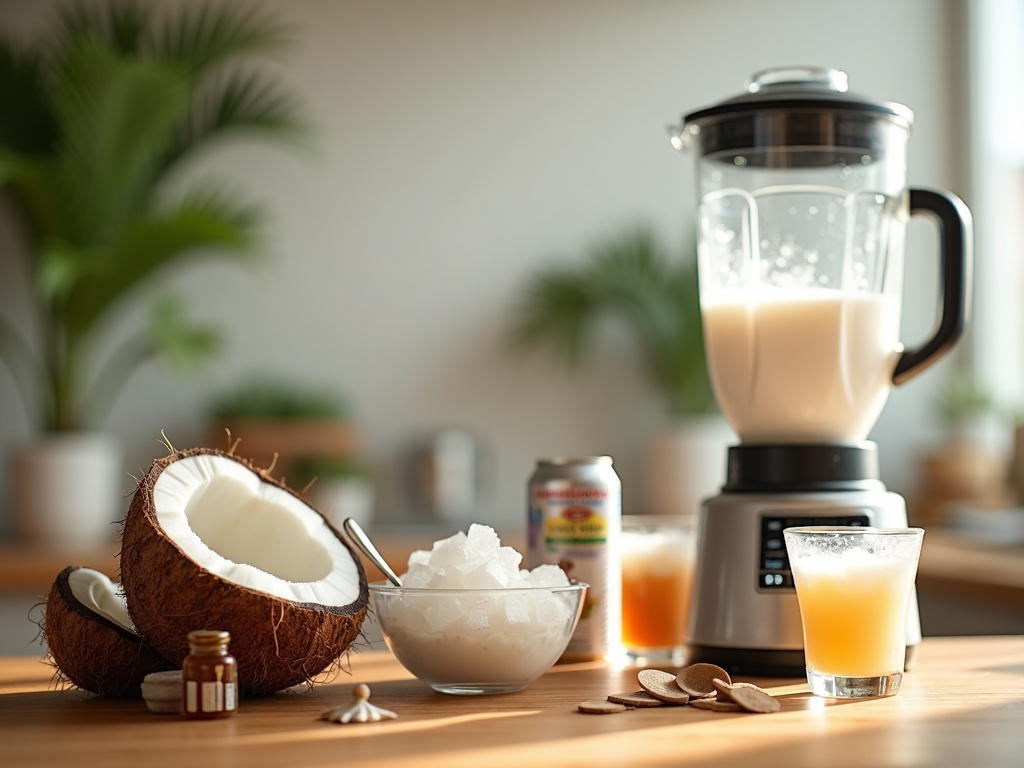
Steps to Blend the Perfect Coconut Shake
Making a coconut shake at home is straightforward once you know the proper technique. I’ve refined this process over time to create consistently delicious results. The secret lies in combining ingredients in the right order and blending them properly.
Preparing Your Ingredients
First, I add fresh coconut meat and coconut milk to my blender. The fresh meat provides authentic flavor that can’t be matched by artificial alternatives. For best results, I scrape the meat directly from a young coconut, though packaged fresh coconut chunks work well too.
When using coconut milk, I opt for full-fat varieties rather than light versions. The higher fat content creates that silky texture that makes coconut shakes so satisfying. If you enjoy coconut shrimp or other coconut dishes, you’ll appreciate the rich flavor profile this creates.
Next, I pour in the remaining ingredients. These typically include:
- 1–2 tablespoons of sweetener (honey, maple syrup, or sugar)
- 1/2 cup of ice cubes
- Optional add-ins like vanilla extract, a pinch of salt, or fruit
Blending and Serving Techniques
I blend everything until the mixture becomes smooth and creamy. Starting at a low speed helps incorporate the ingredients without splashing, then I gradually increase to high power. The process typically takes 30–45 seconds, depending on your blender’s strength.
After blending, I check the consistency by dipping a spoon into the mixture. The perfect coconut shake should coat the back of a spoon yet still be pourable. If it’s too thick, I add a splash more liquid (coconut water or regular milk work well). If it’s too thin, I add more ice or coconut meat.
Finally, I pour the shake immediately into chilled glasses. Serving right away preserves the ideal temperature and texture. For special occasions, I garnish with:
- Toasted coconut flakes
- A mint leaf
- A dash of cinnamon on top
Make It Your Way
The beauty of a coconut shake lies in its versatility. I’ve experimented with countless variations over the years, and that’s what makes this drink so special—you can easily adapt it to suit your taste preferences or nutritional needs.
Flavor Boosters and Add-ins
Fresh fruits can transform your basic coconut shake into something extraordinary. Mango chunks add a tropical sweetness that pairs perfectly with coconut’s natural flavor profile. The combination creates a vacation-in-a-glass effect that’s hard to beat on hot summer days. Banana is another fantastic option, providing creamy texture and natural sweetness while complementing the coconut base. You might also consider pineapple for a piña colada-inspired treat or berries for a colorful twist.
For those looking to make their coconut shake more substantial, protein powder is an excellent addition. After a tough workout, I add a scoop of vanilla or unflavored protein powder to my coconut shake for muscle recovery benefits. This simple addition turns a refreshing beverage into a nutritional powerhouse without sacrificing flavor.
Coconut cream can replace some or all of the coconut milk if you’re craving something extra indulgent. It creates a thicker, more luxurious shake that feels like a proper dessert. Just a quarter cup is enough to dramatically change the texture, making it similar to a coconut ice cream shake.
The sweetness factor is completely customizable too. While standard sugar works fine, try these alternatives for different flavor profiles:
- Honey adds floral notes and natural sweetness
- Maple syrup contributes a rich, caramel-like flavor
- Agave nectar blends seamlessly without overwhelming
- Stevia or monk fruit extract work well for sugar-free options
- Dates can be blended in for fiber along with sweetness
Garnishes and Presentation
Toasted coconut flakes make the perfect finishing touch for any coconut shake. I toast unsweetened coconut flakes in a dry skillet for 2-3 minutes until golden and fragrant, then sprinkle them on top just before serving. The contrast between the cold, smooth shake and the warm, crunchy flakes creates a delightful sensory experience.
Other garnish options can include:
- A dusting of cinnamon or nutmeg
- Dark chocolate shavings for a coconut-chocolate combo
- A fresh mint sprig for color contrast
- A pineapple wedge on the rim for tropical flair
- A light drizzle of caramel or chocolate sauce
Don’t forget about presentation—serving your coconut shake in a chilled glass makes a difference. For special occasions, I like to rim the glass with lime juice and dip it in toasted coconut flakes before pouring in the shake.
The temperature matters too. If using frozen fruit, you might need less ice to achieve the perfect consistency. Conversely, if using fresh fruit, more ice or frozen coconut milk cubes can help achieve that ideal frosty texture without watering down the flavor.
These customizations aren’t just about flavor—they’re about making your coconut shake fit your lifestyle. Whether you need a protein-packed recovery drink, a dairy-free dessert alternative, or simply a refreshing tropical treat, the humble coconut shake can be transformed to meet your exact needs.
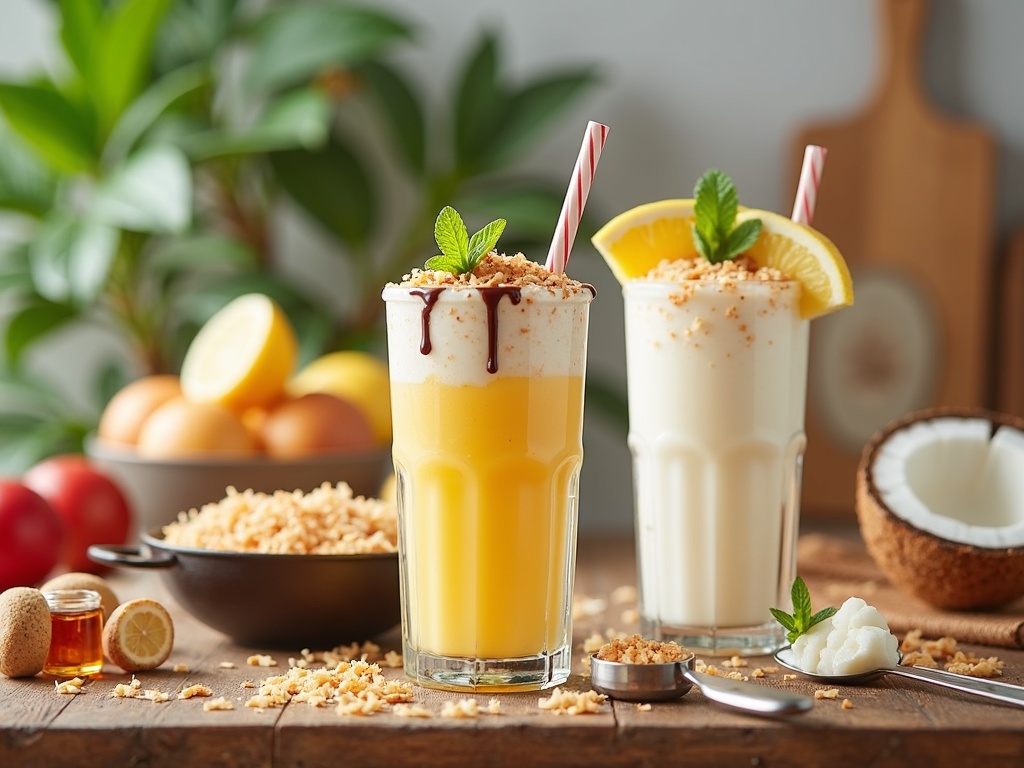
Common Mistakes to Skip
Making a coconut shake seems straightforward, but there are several pitfalls that can turn your tropical treat into a disappointing drink. I’ve made these mistakes myself and learned what works through trial and error. Let me walk you through the most common errors to avoid when preparing your coconut shake.
Ingredient Quality Matters
Using low-quality coconut milk is perhaps the biggest mistake you can make. The coconut milk serves as the foundation of your shake, and its quality directly impacts the final taste. Cheap coconut milk often contains additives, preservatives, and less actual coconut content. This results in a watery consistency and artificial flavor that no amount of sugar or flavoring can mask.
For a truly delicious coconut shake, I always opt for premium coconut milk with high fat content. Look for brands that list coconut and water as the only ingredients. The difference is immediately noticeable in the creaminess and authentic coconut flavor. If you enjoy coconut-based recipes, you might also like my crispy coconut shrimp recipe which similarly relies on quality coconut products.
Adding too much ice is another common error. While ice gives your shake that refreshing chill, overdoing it dilutes the flavor and creates a slushy texture instead of a creamy shake. Start with a small amount of ice and add more gradually if needed. For an extra creamy texture without dilution, try freezing coconut milk ice cubes ahead of time.
Blending Techniques
Blending for too long can ruin your coconut shake’s texture. Unlike smoothies that benefit from extended blending, coconut shakes quickly become thin and frothy when over-processed. The fat in coconut milk breaks down, losing that luxurious mouthfeel that makes the shake so satisfying.
I’ve found that pulsing the blender in short bursts works best. Aim for about 20–30 seconds total blending time, stopping once the ingredients are just combined. This preserves the rich texture while ensuring everything is properly mixed.
Forgetting to taste and adjust is a mistake even experienced shake makers commit. Coconut milk varies in sweetness and richness between brands, so following a recipe exactly might not yield the best results. After blending, take a moment to taste your creation and make adjustments:
- If it’s too thick, add a splash of coconut water
- If it lacks sweetness, incorporate a bit more honey or maple syrup
- If the coconut flavor is too subtle, a drop of coconut extract works wonders
- If it needs more richness, a spoonful of coconut cream can transform the texture
This taste-and-adjust approach ensures your coconut shake matches your personal preferences rather than following a one-size-fits-all recipe.
The temperature of your ingredients also impacts the final product. Using room-temperature coconut milk and then adding cold ingredients creates uneven cooling and poor texture integration. I always chill my coconut milk for at least an hour before making shakes to ensure consistent cooling.
With these mistakes in mind, you’ll be well-equipped to craft the perfect coconut shake. The difference between an ordinary shake and an exceptional one often comes down to avoiding these simple errors and paying attention to quality and technique.
Pro Tips for the Best Results
I’ve perfected my coconut shake technique through years of trial and error. These simple adjustments will transform your ordinary coconut shake into something extraordinary.
Temperature and Preparation Matters
Cold ingredients make all the difference in creating a refreshing coconut shake. I always chill my coconut milk in the refrigerator for at least 4 hours before using it. This not only enhances the flavor but also creates that perfect creamy texture without needing extra ice that might water down your shake.
Any fruits you’re adding should also be frozen beforehand. Frozen mango chunks or pineapple pieces work wonderfully with coconut flavors and help create that thick, milkshake-like consistency that makes coconut-based drinks so satisfying.
For an extra cold treat, I sometimes chill the blender jar in the freezer for about 10 minutes before mixing. This keeps everything frosty from start to finish.
Perfecting Your Flavor Profile
Finding the right sweetness balance takes finesse. I start with less sweetener than I think I’ll need, then taste and adjust. Natural sweeteners like honey or maple syrup complement the coconut flavor better than refined sugar.
Here’s how I approach the perfect flavor balance:
- Add sweetener in small increments (about 1 teaspoon at a time)
- Blend briefly after each addition
- Taste before adding more
- Remember that fruits will add natural sweetness
- Consider a pinch of salt to enhance the coconut flavor
If you’re looking for the smoothest possible texture, straining your coconut shake through a fine mesh sieve will remove any fibrous bits. This step is optional but delivers a silky result that feels more luxurious.
Timing matters too. I always serve coconut shakes immediately after blending. They tend to separate if left sitting, and the temperature and texture are at their prime when freshly made. If you must make them ahead, a quick re-blend before serving will restore that perfect consistency.
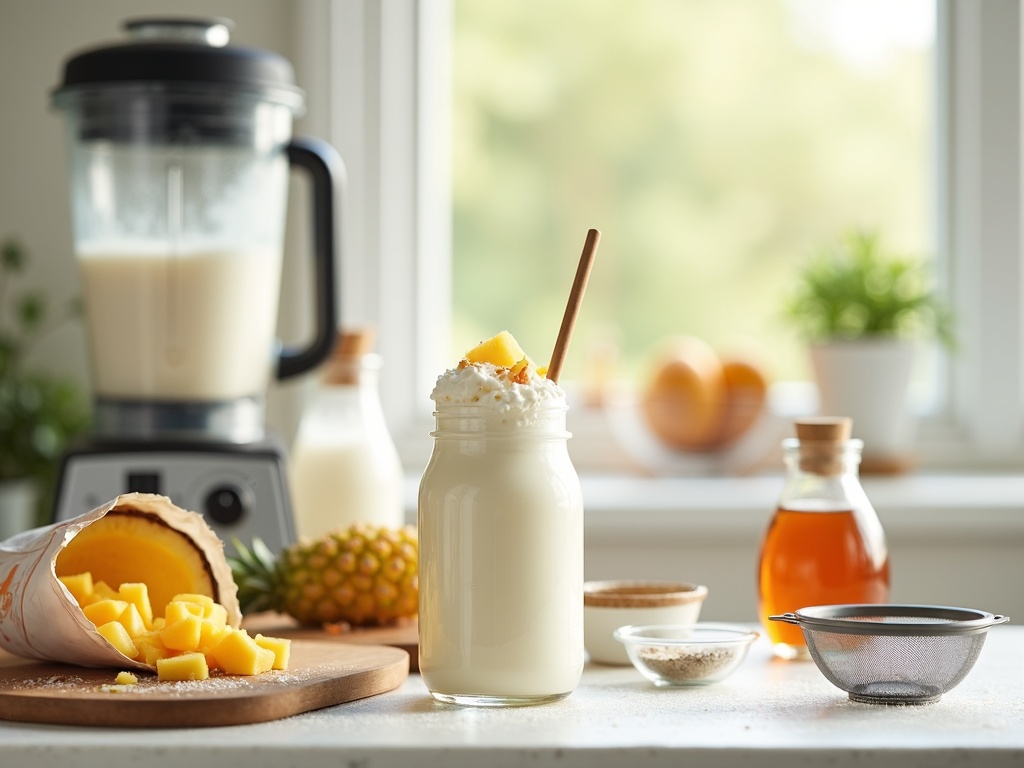
Storage Guidelines
I’ve found that storing coconut shakes properly maintains their flavor and texture, though nothing beats enjoying them fresh. These tropical delights deserve careful handling to preserve their creamy consistency and refreshing taste.
Fresh Is Best
Coconut shakes taste best when consumed immediately after preparation. The fresh combination of coconut milk, ice, and other ingredients creates a perfect texture that gradually changes over time. When served fresh, you’ll experience:
- Maximum creaminess and ideal temperature
- Optimal flavor profile with balanced sweetness
- Perfect blending of all ingredients without separation
- Freshest coconut taste and aroma
If you’re hosting a gathering, I recommend preparing coconut shakes just before serving. This timing ensures your guests enjoy the authentic taste experience similar to what you’d find in tropical destinations.
Proper Storage Techniques
If you need to prepare your coconut shake ahead of time, you can store it for up to 24 hours while maintaining acceptable quality. Follow these storage guidelines for the best results:
- Use an airtight container to prevent the shake from absorbing other flavors from your refrigerator. Glass containers work particularly well for maintaining flavor integrity.
- Keep your shake refrigerated at all times. The cold temperature slows down separation and helps preserve the coconut milk’s freshness.
- Leave minimal headspace in your container to reduce oxidation, which can affect flavor.
- Place the container toward the back of your refrigerator where the temperature remains most consistent.
- If you’ve made a larger batch, consider dividing it into individual serving containers to minimize exposure to air each time you grab a portion.
When it’s time to serve your stored coconut shake, you’ll notice some separation has likely occurred. This is completely normal with coconut-based beverages. Simply give it a thorough stir or a quick pulse in the blender to remix the ingredients.
The natural fats in coconut milk tend to rise to the top during storage, creating distinct layers. A quick remix redistributes these components, restoring the shake’s original creamy texture.
For a truly special treat, consider making my coconut shrimp recipe as an accompaniment to your shake – the complementary coconut flavors create a delightful tropical meal experience.
I’ve noticed that frozen ingredients like ice or frozen fruit chunks will continue to melt during storage, potentially diluting your shake. If preparing in advance, consider making your original mixture slightly more concentrated to account for this dilution.
Remember that while stored coconut shakes remain safe to consume for several days, their quality deteriorates significantly after the first 24 hours. The delicate flavors begin to fade, and the texture becomes increasingly watery as time passes.
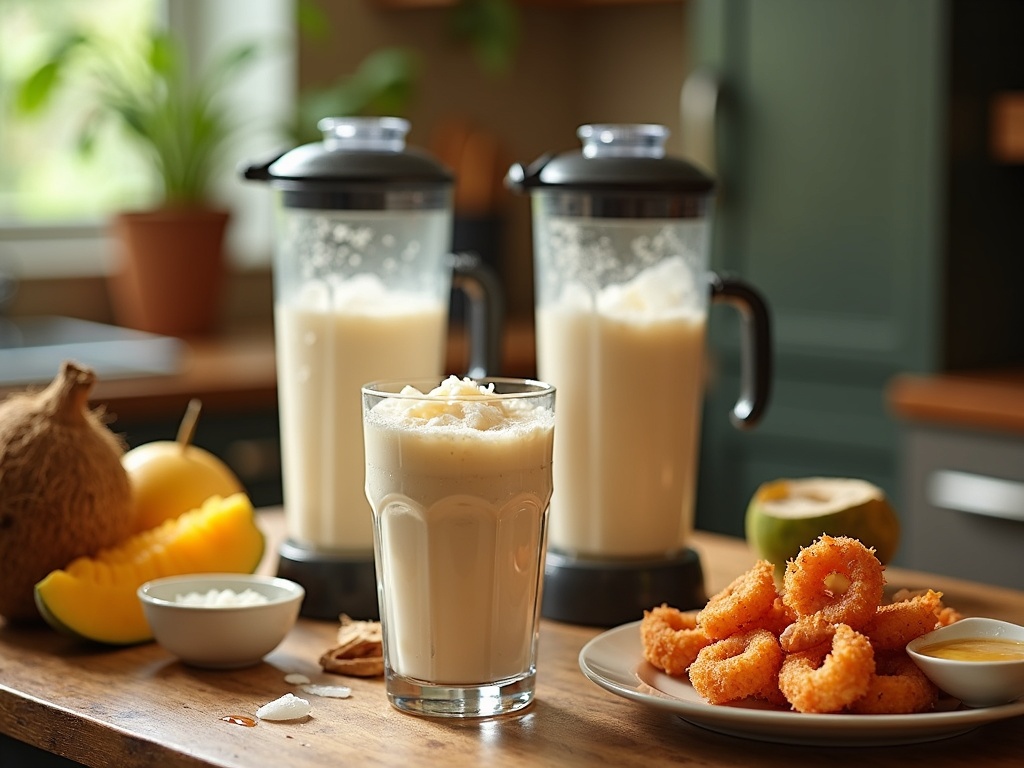
Nutritional Benefits
Coconut shakes offer an impressive array of health benefits beyond their delicious taste. I’ve found them to be a fantastic addition to my diet for both their flavor and nutritional advantages.
Powerhouse of Essential Nutrients
Coconut is a good source of healthy fats, particularly medium-chain triglycerides (MCTs). Unlike long-chain fatty acids, MCTs are rapidly absorbed and converted into energy rather than being stored as fat. This makes coconut shake an excellent option for sustained energy without the crash associated with sugary drinks.
The electrolyte content in coconut makes these shakes particularly beneficial after exercise or during hot weather. Coconut water naturally contains potassium, sodium, magnesium, and calcium—all essential electrolytes that help maintain proper fluid balance in the body. These electrolytes work together to:
- Support muscle function and prevent cramping
- Regulate nerve signals throughout the body
- Aid in post-workout recovery
- Help maintain proper hydration levels
Coconut shakes also deliver important vitamins and minerals your body needs. Each serving provides:
- Vitamin C for immune support
- B vitamins for energy metabolism
- Manganese for bone health and antioxidant protection
- Iron for healthy blood cells
- Zinc for immune function
The natural energy boost from coconut shakes comes from their unique combination of MCTs, natural sugars, and electrolytes. Unlike caffeine or artificial energy drinks, the energy from coconut shakes is steady and sustained, making them perfect for morning consumption or as an afternoon pick-me-up.
I’ve noticed that drinking coconut shakes regularly helps with hydration. The natural electrolytes in coconut enhance the body’s ability to retain fluid, making these shakes more effective at hydrating than plain water in some situations. This hydrating property is especially valuable:
- After intense physical activity
- During hot summer days
- When recovering from illness
- As part of a balanced approach to daily hydration
For an added nutritional boost, I sometimes combine coconut with other nutritious ingredients like protein-rich foods to create a more complete meal replacement. The healthy fats in coconut also help with the absorption of fat-soluble vitamins (A, D, E, and K), making coconut shakes an excellent vehicle for maximizing nutrient intake.
The fiber content in coconut meat, often included in thicker coconut shakes, supports digestive health and helps maintain stable blood sugar levels. This makes coconut shakes a better choice than many commercially available smoothies or shakes that might spike blood sugar due to added sugars.
For those with dietary restrictions, coconut shakes offer a dairy-free alternative that doesn’t compromise on creaminess or nutritional value. They’re naturally free from lactose and gluten, making them accessible to people with various food sensitivities.
It’s worth noting that while coconut is high in saturated fat, the type of saturated fat it contains (MCTs) doesn’t appear to have the same negative effects on heart health as saturated fats from animal sources. However, moderation is still key—enjoying coconut shakes as part of a varied diet is the best approach for maximizing their benefits without overdoing calorie intake.

